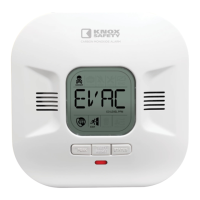These symptoms are related to CO POISONING and should be discussed
with ALL household members:
• Mild Exposure: Slight headache, nausea, vomiting, fatigue ("flu-like"
symptoms).
• Medium Exposure: Throbbing headache, drowsiness, confusion, fast
heart rate.
• Extreme Exposure: Convulsions, unconsciousness, heart and lung failure.
Exposure to carbon monoxide can cause brain damage, death.
WARNING!
Many cases of reported CO POISONING indicate that while victims are aware they
are not well, they become so disoriented they are unable to save themselves by
either exiting the building or calling for assistance.
IMPORTANT!
This CO alarm measures exposure to CO over time. It alarms if CO levels are
extremely high in a short period of time, or if CO levels reach a certain minimum
over a long period of time. The CO alarm generally sounds an alarm before the
onset of symptoms in average, healthy adults. Why is this important? Because you
need to be warned of a potential CO problem while you can still react in time. In
many reported cases of CO exposure, victims may be aware that they are not
feeling well but become disoriented and can no longer react well enough to exit
the building or get help. Also, young children and pets may be the first affected.
The average healthy adult might not feel any symptoms when the CO alarm
sounds. However, people with cardiac or respiratory problems, infants, unborn
babies, pregnant mothers, or the elderly can be more quickly and severely
affected by CO. If you experience even mild symptoms of CO poisoning, consult
your doctor immediately!
HOW CAN I PROTECT MY FAMILY FROM CO POISONING?
A CO alarm is an excellent means of protection. It monitors the air and sounds a
loud alarm before carbon monoxide levels become threatening for average,
healthy adults. A CO alarm is not a substitute for proper maintenance of home
appliances.
TO HELP PREVENT CO PROBLEMS AND REDUCE THE RISK OF CO
POISONING:
• Clean chimneys and flues yearly. Keep them free of debris, leaves, and nests for
proper air flow. Also, have a professional check for rust and corrosion, cracks, or
separations. These conditions can prevent proper air movement and cause
backdrafting. Never "cap" or cover a chimney in any way that would block air
flow.
• Test and maintain all fuel-burning equipment annually. Many local gas or oil
companies and HVAC companies offer appliance inspections for a nominal fee.
• Make regular visual inspections of all fuel-burning appliances. Check appliances
for excessive rust and scaling. Also check the flame on the burner and pilot
lights. The flame should be blue. A yellow flame means fuel is not being burned
completely and CO may be present. Keep the blower door on the furnace
closed. Use vents or fans when they are available on all fuel-burning appliances.
Make sure appliances are vented to the outside. Do not grill or barbecue
indoors, or in garages or on screened-in porches.
• Check for exhaust backflow from CO sources.
• Check the draft hood on an operating furnace for backdraft. Look for cracks on
furnace heat exchangers.
• Check the house or garage on the other side of shared wall.
• Keep windows and doors open slightly. If you suspect that CO is escaping into
your home, open a window or a door. Opening windows and doors can
significantly decrease CO levels.
In addition, familiarize yourself with all enclosed materials. Read this manual
in its entirety, and make sure you understand what to do if your CO
alarm sounds.
SYMPTOMS OF CO POISONING
15

